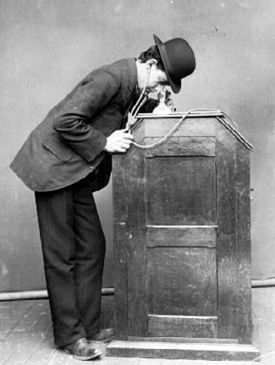

But political fear is more than an individual experience, and it affects more than personal lives. The morals contributing to it descend from tradition and popular belief, and the rational calculus underlying it reflects the realities of social and political power. Whether by design or consequence—for sometimes the outcome is intended, other times not—political fear reinforces a society’s distribution of power and resources, influences public debate, and compels public policy.
— Corey Robin
In 1894, one of the first films ever was censored by the mayor of Newark, New Jersey. The films is titled Carmencita. It was censored because, during the dance, the woman’s underwear is (briefly) visible. But this was a minor act of censorship compared to what would happen three years later.
Thomas Edison (aka the Wizard of Menlo Park) commercialized moving picture technologies (henceforth referred to as film in this post) in 1894. At that time period, boxing was a popular albeit illegal sport (mainly illegal because people died from the sport during that time period). 4 men had the idea of recording the fights to make money off of them, named Otway Latham, Grey Latham, Samuel Tilden, and Enoch Rector. It would be Grey Latham who initially came up with the idea of recording boxing matches. The four of them would form the Kinetoscope Exhibiting Company, formed for the intention of filming boxing matches. At the time, even with access to Edison’s lab, they would only be able to make films of a length no longer than one minute.

During that time, boxing fights would be recorded and replayed later on, from Edison’s studio Black Maria in Orange County, New Jersey. While the Kinetoscope Exhibiting Company eventually proved profitable with the fights, Edison publicly denounced the filming of boxing matches in late December of 1894. Even though Edison was known to enjoy boxing, this didn’t stop him from attempting to keep a good public image with his companies. This marked the first instance of self-censorship with films, though Edison was half-assed about it. Despite Edison’s public denouncement, he and his company continued to take in revenue from boxing matches that were filmed and shown. This would continue on for a few years.
In 1896, Edison renewed his objections to boxing. During that same year, a 20 second short film titled The Kiss made it into Edison’s kinetoscopes. Thomas Edison pretty much had a monopoly on all films and all film patents at this point in time, thanks in-part to his Motion Picture Patents Co. This monopoly would prove problematic to an industry striving for growth due to other artists who wanted their shot at film-making. Until then, it had its first controversy, with some outrage over the content of the film The Kiss. Because it was the first on-screen depiction of a couple kissing. Because kissing in public back then was frowned upon, particularly by the Roman Catholics.
Otway and Grey, the Latham brothers, eventually evolved the concept of film display by creating a projector within their Lambda Company. This projector would be patented as the Latham Loop. It would be named the pantopticon, and then later renamed to eidoloscope. By 1895, they had demonstrated this new technology publicly. Later on, even Enoch Rector separated from Edison to try his own hand independently at filming, with his own camera.



By 1896, boxing was practically banned everywhere in the United States. The less violent and more erotic films weren’t fairing much better in some cases. In the case of Fatima’s Coochie-Coochie Dance, there was a censored and uncensored version, where the censored cut had white bars over portions of the screen to make the dance less visually enticing for the viewer. So now there’s an act of censorship where the film wasn’t banned from display so much as there was an edited and non-edited version.
However, back to the topic of boxing, a lobbying effort in Nevada convinced the state to legalize boxing. March 17, 1897, a match between James Corbett and Bob Fitzsimmons took place in Carson, Nevada. Enoch J. Rector recorded this match, and attempted to distribute it in an effort to get around the current laws. Within two days of the match ending, efforts were made to restrict the exhibition of this fight through any means involving motion-pictures. On March 20, 1897, the state of Maine succeeded, with the first ever direct legislative act in the United States aimed at censoring film:
Any Person exhibiting publicly any photographic or other reproduction of prize fight shall be punished by a fine not exceeding five hundred dollars.
Regardless, in May 22, 1897, the film of the boxing match was shown in New York to an audience of two thousand people. A couple months later, on July 26, 1897, Los Angeles, California followed in Maine’s steps with their own film censorship ordinance regarding fights in kenetoscopes.
The State/city censorship laws ended up not mattering in the end. They couldn’t fight back against the demand for viewing a boxing match. If the demand is great enough, nothing can really stop people from getting what they want. No matter what hurdles the suppliers have to go through, they will find a way to meet the demand if it is high enough for them to make a profit, which Rector certainly did. But this was just the beginning of the controversies that would come from film. And the biggest of the controversies started with the filming of an illegal sport. To a lesser extent, there was also what was considered indecency via displaying two people kissing. Even in its origins, film was controversial because of the sex and the violence.
Relevance to Today
Basically, politicians and religious groups didn’t want this new technology displaying acts ranging from inappropriate behavior to illegal. That is something which today’s society, at least as of 2018 in America, doesn’t have to worry about all that much. We have films portraying criminals robbing banks, selling/smuggling drugs, drug use, portraying illegal aliens in a positive light, heterosexual sex, homosexual sex, rape, cock-fighting, animal-fighting, underground bloodsports, etc. We can pretty much have films like that exist without much fuss over them portraying inappropriate behavior. The only restrictions, which are basically determined by the MPAA rating system which has the indirect power of controlling what can and cannot be shown in theaters. It’s not so much the content they restrict so much as is how explicit the content should be. “Hey, don’t push it, or we’ll give you an NC-17 rating!”
But what is relevant to today is the self-censorship stance Edison took regarding boxing. He enjoyed the sport, and had no qualms about exhibiting a filming of the sport. But he had to fall back from his position due to pushback from state laws and various public outcries. That sort of thing still happens to this day. For instance, when that film Gangster Squad had to change the finale due to shootings at a movie theater (the finale did something a bit similar). In many of these cases, the censorship happens for good reasons on the surface level. However, as time has shown, boxing became more accepted over the years. The self-censorship done by Edison proved futile in the long-run. Because when discussing boxing, it eventually came to be an accepted sport with rules enforced to make it safer, but didn’t dampen the skill involved with the fighters. In a similar scenario, self-censoring certain portrayals of gun violence prevents people from expressing their opinions about it, inviting discussion. If it must be censored in those situations at all times, that will also forbid people from even thinking about the subject, let alone discussing it. Preventing discussion is a crime against progress.
The process of self-censorship was incredibly insidious: It wasn’t just that you stopped talking about certain things with other people—you stopped thinking them yourself.
— Anonymous psychoanalyst from Montevideo, Uruguay
Sources
Orbach, Barak Y. (2009) “Prizefighting and the Birth of Movie Censorship” Yale Journal of Law & the Humanities: Vol. 21, Issue 2, Article 3. https://digitalcommons.law.yale.edu/cgi/viewcontent.cgi?referer=http://digitalcommons.law.yale.edu&httpsredir=1&article=1348&context=yjlh
“History of Sex in Cinema” AMC FilmSite. https://www.filmsite.org/sexinfilms1.html
Sacks, Ethan. August 22, 2012. “Ryan Gosling films ‘Gangster Squad’ Reshoots in Los Angeles” NY Daily News. https://www.nydailynews.com/entertainment/tv-movies/ryan-gosling-films-gangster-squad-reshoots-los-angeles-article-1.1141880
Robin, Corey. February 7, 2017. “Beware of Self-Censorship” The New Republic. https://newrepublic.com/article/140458/beware-self-censorship
“The First Banned Films — Including the First ‘Adult Film'” Yestervid. http://yestervid.com/first-banned-film-and-first-adult-film/

[…] 0, Part 1, Part 3 Part 2, Part 4, Part […]
LikeLike
[…] 0, Part 1, Part 3 Part 2, Part 4, Part […]
LikeLike